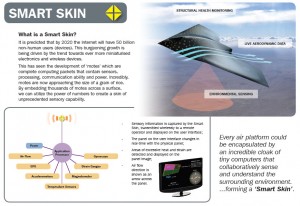BAE Systems announced last month that its Advanced Technology Centre is working on a “smart skin” for aircraft fuselages that have thousands of micro-sensors – known as motes – that are capable of sending back detailed information in real time.

According to the news release by BAE Systems, the “smart skin” has been developed by Senior Research Scientist Lydia Hyde who was inspired by the ability of her clothes dryer to switch itself off if it overheats.
“Observing how a simple sensor can be used to stop a domestic appliance overheating, got me thinking about how this could be applied to my work and how we could replace bulky, expensive sensors with cheap, miniature, multi-functional ones. This in turn led to the idea that aircraft, or indeed cars and ships, could be covered by thousands of these motes creating a ‘smart skin’ that can sense the world around them and monitor their condition by detecting stress, heat or damage. The idea is to make platforms ‘feel’ using a skin of sensors in the same way humans or animals do,” said Ms Hyde.
“By combining the outputs of thousands of sensors with big data analysis, the technology has the potential to be a game-changer for the UK industry. In the future we could see more robust defence platforms that are capable of more complex missions whilst reducing the need for routine maintenance checks. There are also wider civilian applications for the concept which we are exploring.”
With the smart skin, the aircraft of the future will be able to instantly detect damage, measure a wide range of variables, like temperature, wind speed, strain, corrosion and power themselves by using energy-harvesting technology.
The smart sensors will most definitely speed up costly maintenance procedures and will allow dealing with all sorts of problems before they grow into something serious.
The researchers are currently exploring the possibility of including a single pixel light sensor that could potentially turn the entire surface of the aircraft into a giant camera.




















